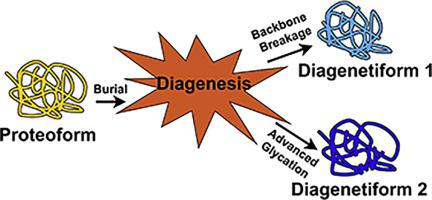Journal of Proteomics ( IF 2.8 ) Pub Date : 2020-09-28 , DOI: 10.1016/j.jprot.2020.103992 Timothy P Cleland 1 , Elena R Schroeter 2 , Caitlin Colleary 3

|
The term proteoform describes all combinations of change in a protein, as elucidated through intact mass proteomics. Paleoproteomic studies have begun using digestion-free and top-down techniques to access information from ancient and historical remains. However, to discuss protein changes that uniquely occur to archaeological and paleontological proteomes as the result of diagenesis (i.e., physical and chemical change imparted by burial), a novel term is needed that both addresses issues of combinatorics and distinguishes diagenetic-specific alteration.
Significance
The term diagenetiform provides the opportunity to communicate clearly the sets of diagenetic changes found on preserved proteins. The diagenetiform nomenclature will allow for top-down paleoproteomic studies to accurately describe the total changes detected on ancient proteins.
中文翻译:

成岩性:解释古生物学中成岩作用的蛋白质变化的新术语
蛋白质组学术语描述了蛋白质变化的所有组合,如完整的蛋白质组学所阐明的那样。古蛋白质组学研究已开始使用无消化和自上而下的技术从古代和历史遗迹中获取信息。但是,要讨论成岩作用在考古和古生物学蛋白质组中唯一发生的蛋白质变化(即,由埋葬引起的物理和化学变化),需要一个新颖的术语既解决组合问题,又区分成岩作用特异性改变。
意义
术语成岩作用提供了机会,以清晰地传达在保留的蛋白质上发现的成岩作用变化的集合。该成岩形式的命名将允许自上而下的古生物学研究准确地描述在古代蛋白质上检测到的总变化。











































 京公网安备 11010802027423号
京公网安备 11010802027423号